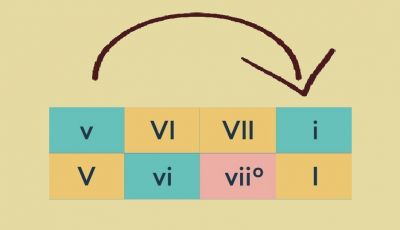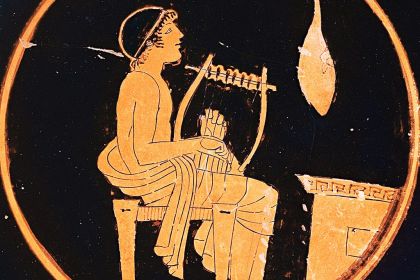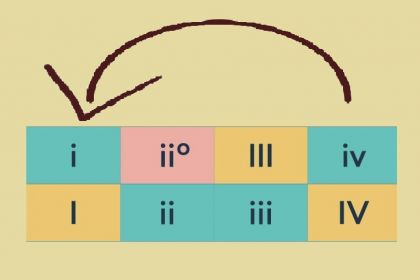Music Theory
Authentic cadence exemplified by The Beatles songs

Roman numerals indicating chords of minor and major scales
In theory, a cadence refers to a harmonic turnaround that appears at the end of a musical phrase, and the role it plays for the listener's perception of the entire work is similar to the function of punctuation marks that facilitate better comprehension of a text. The correct use of cadences in vocal music provides the right balance between the two kinds of emotions: the one communicated through the lyrics and that evoked by the accompanying music.
The authentic cadences—involving a main dominant chord and a tonic triad—is the most common technique for finalizing classical pieces or any of their movements. All types of cadences have been organically utilized in popular music where they are widely applied to close song verses and choruses (or some of their lines) as well as to round off instrumental sections.
Generally, authentic cadences are classified as perfect and imperfect. The perfect authentic cadence is rightfully considered the strongest final structure and is invariably expressed by the major dominant chord rooted in the fifth scale degree which resolves into the tonic triad precisely on the strong beat of the measure V–I. Here both numerals are capitalized according to the rules of harmonic analysis in which major chords are marked with uppercase Roman numerals and minor chords with lowercase Roman numerals.
Both chords forming a perfect authentic cadence must be applied at the root position with the final chord containing a tonic in the highest voice. In cases where a tonic chord appears on a weak beat or chords are not applied at root positions, an authentic cadence is considered imperfect. The v–i progression is also considered to be an imperfect authentic cadence since a minor dominant chord does not contain the leading-tone and its resolution into the tonic triad does not sound final.
A fine example of chord progressions—typically performed within perfect authentic cadences in the major mode—is shown in The Beatles' Tell Me What You See composed entirely in G Ionian. The chord progressions used for each line of the verses are as follows:
- G–C–D–G or I–IV–V–I
- G–C–G or I–IV–I
- G–C–D–G or I–IV–V–I
- C–D–G or IV–V–I
Chords D and G appear at the end of lines 1, 3, and 4 in exactly the right order to form the V–I perfect authentic cadence while line 2 reveals the post-cadential plagal turnaround. The song's choruses are based on two progressions where the first three lines contain the IV–I plagal cadence, and the last line shows clear signs of the V–I perfect authentic cadence:
- C–G or IV–I for lines 1-3
- C–D–G or IV–V–I for line 4
Curiously, the IV–V–I sequence, with its subdominant triad rooted in the fourth scale degree and followed by an authentic cadence, contains all three diatonic functions arranged in the most natural order: subdominant-dominant-tonic. The juxtaposition of the primary subdominant triad with the dominant triad always creates an expectation of the tonic chord, therefore such perfect authentic cadences usually close classical pieces and their sections contribute to the establishment of the tonic function.
Another nuance associated with the perfect authentic cadence can be observed in the bridges built on the chord chain G7–C–G–D7–G or I7–IV–I–V7–I. The authentic cadence appears at the end of the sequence and contains the V7 dominant seventh chord that tends to resolve into a more impactful tonic chord than the one resolved by a simple V dominant triad.
Listen to Tell Me What You See by The Beatles:
In tonal theory, various musical forms, including period, binary, and ternary forms, are often constructed from a group of phrases that consist of at least one antecedent phrase and one consequent phrase. A perfect authentic cadence usually closes the consequent phrase while the end of an antecedent phrase creates a sense of instability by using the half authentic cadence, often referred to as the semicadence.
Although classical musical forms are rarely found in popular music, the half authentic cadences can be sometimes found at the end of looped chord progressions such as in The Beatles' You're Going To Lose That Girl written in E Ionian:
- E–C♯m–F♯m–B7 or I–vi–ii–V7 for choruses
- E–G♯m–F♯m–B7 or I–iii–ii–V7 for verses
Each line of verses and choruses ends with the dominant B7 seventh chord creating tension which is then resolved by the tonic E chord at the beginning of the next line. This semicadence also reveals the classical technique of using the ii supertonic chord before the dominant chord.
Listen to You're Going To Lose That Girl by The Beatles:
The examples given show authentic cadences in the major mode where their use is the most convenient. In the natural minor mode, such cadences are rare since the minor dominant chord rooted in the fifth scale degree does not create sufficient tension and its resolution into the tonic chord is not so obvious.
However, the imperfect authentic cadences that combine chords rooted in the fifth and first scale degrees are by no means a rarity in minor modes as showcased in The Beatles' Happiness Is A Warm Gun. The first verse of the song is written in A Aeolian and begins with a chord sequence which can be interpreted as an imperfect authentic cadence Am–Em–Am–Em or i–v–i–v. The remaining lines of the verse are laid out against the chord alternation in a show of a typical plagal cadence found in the natural minor mode Dm–Am or iv–i.
Listen to Happiness Is A Warm Gun by The Beatles:
To perform the perfect authentic cadence in the natural minor mode, a major dominant chord is usually written V–i. In this case, the subtonic is altered, turning into the leading-tone tone, and the resulting scale is called the harmonic minor scale.
A clear example of such a perfect authentic cadence can be found in The Beatles' You Never Give Me Your Money where the cadence acts as a crowning jewel of a well-developed chord chain composed in the spirit of the Classics. The first two verses of the song, written in A Aeolian, reveal the powerful cadence involving the E major dominant chord at the end of the fourth line: Am7–Dm7–G–C–Fmaj7–Dm–E–Am or i7–iv7–VII–III–VI7–iv–V–i.
Listen to You Never Give Me Your Money by The Beatles:
It is noteworthy that a range of authentic cadences is so surprisingly exemplified in the songs of The Beatles whose work also reveals many other aspects of the tonal theory. The fact that the band organically combined the compositional methods specific to pop, folk, and classical music in their oeuvre is one of the main reasons behind the enduring quality of their music.



